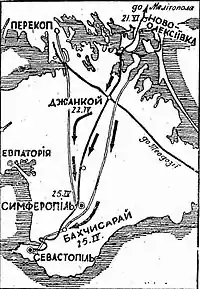Crimea Operation (1918)
The Crimea Operation was a combined military offensive by Imperial German and Ukrainian forces in April 1918 against the Taurida Soviet Socialist Republic.[1][2]
| Crimea Operation (1918) | |||||||
|---|---|---|---|---|---|---|---|
| Part of the Eastern Front of World War I, the Southern Front of the Russian Civil War and the Ukrainian–Soviet War | |||||||
 German and Ukrainian advances from Novooleksiivka to Sevastopol from 21 April to 25 April 1918 | |||||||
| |||||||
| Belligerents | |||||||
|
| |||||||
| Commanders and leaders | |||||||
| |||||||
Background
Following the Russian Revolution in December 1918, the Crimean People's Republic was declared which encompassed the entire territory of Crimea. However, this proclamation was challenged by Bolshevik forces and by January 1919, Crimea was overrun and the Taurida Soviet Socialist Republic was declared.[3] Upon seizing Crimea, Bolshevik forces enacted a campaign of terror upon the Crimean Tatar population, killing Muslim clerics and wealthy landowners with the express goal of eliminating the Tatarian "bourgeois nationalists".[4] In addition to the internal campaign of terror, Bolshevik forces attacked Ukrainian and German forces in the neighboring Ukrainian People's Republic.[5]
Operation
The Taurida Soviet Socialist Republic was quickly overrun by German and Ukrainian forces under command of Petro Bolbochan during the Crimean Offensive.[6][4] The relative quick pace of the operation was due to desertion and widespread demoralization amongst the forces of Taurida, in addition to simultaneous peasant revolts across Crimea.[7] By the end of April 1918, the majority of the members of the Central Executive Committee and the Council of People's Commissars, including council leader Anton Slutsky and local Bolshevik chief Jan Tarwacki, were arrested and shot in Alushta by insurgent Crimean Tatars, partially in reaction to the prior killing of Tatar independence leader Noman Çelebicihan by the Bolsheviks earlier in February. On 30 April, the Taurida SSR was abolished and former Chief of Staff Mikhail Sablin raised the colours of the Ukrainian People's Republic on 29 April 1918.[8]
Aftermath
Despite the offensive violating the terms of the Treaty of Brest-Litovsk, German forces immediately set up a military administration in Crimea against the wishes of the local Tatar population. General Erich Ludendorff began plans to set Crimea up as a German colony and used the territory as a stepping stone for German offensives in the Caucasus region.[9]
References
- Tynchenko, Yaros (23 March 2018), "The Ukrainian Navy and the Crimean Issue in 1917-18", The Ukrainian Week, retrieved October 14, 2018
- Germany Takes Control of Crimea, New York Herald (18 May 1918)
- Plokhy, Serhii (2017). The Gates of Europe - A History of Ukraine. New York: Basic Books. ISBN 9780465093465.
- Magocsi, Paul R. (2010). A History of Ukraine - The Land and Its Peoples. Toronto: University of Toronto Press. p. 545. ISBN 9781442610217.
- Department of State, United States. (1931). Russia: 1918. Washington: United States Government Printing Office. p. 533.
- (in Ukrainian) Hrabovsky, S. Три місяці свободи, The Ukrainian Week. 19 February 2008.
- Pipes, Richard (1997). The Formation of the Soviet Union - Communism and Nationalism, 1917-1923, First Edition. United States of America: Harvard University Press. ISBN 9780674417649.
- Operation Fleet For Ukraine, The Ukrainian Week (16 May 2011)
- Holborn, Hajo (1982). A History of Modern Germany - Volume 3 1840-1945. New Jersey: Princeton University Press. p. 488. ISBN 0-691-05359-6.